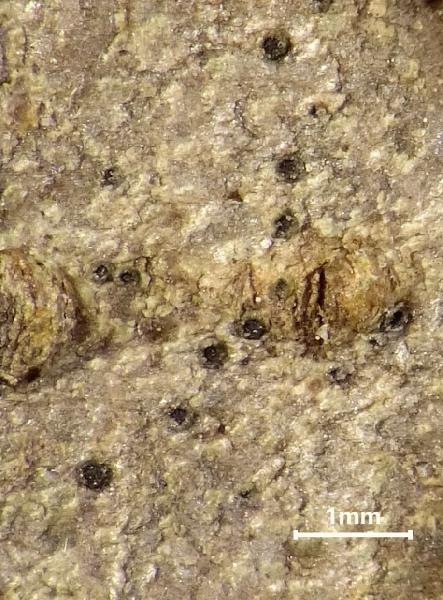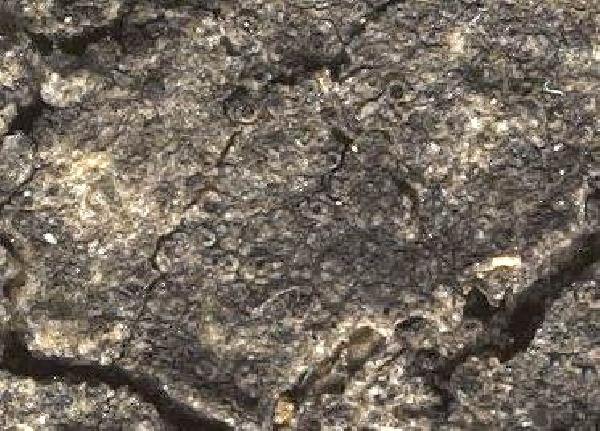Rinodina polysporoides Giralt & H. Mayrhofer
Herzogia, 10: 33, 1994.
Synonyms:
Description: Thallus crustose, episubstratic, thin, discontinuous, smooth to finely verrucose, rimose-areolate, grey, dark grey or greyish-green, without a distinct prothallus. Apothecia lecanorine, usually scattered to confluent, broadly attached, 0.2-0.4 mm across, with a persistently flat, dark brown to black disc, and a rather thick entire to flexuose, rarely finally excluded thalline margin. Thalline exciple 40-70 µm wide laterally, corticate, the cortex 10-20 µm thick in lower part, I+ faintly blue; proper exciple 5-10 µm wide laterally, expanded to 20-30 µm in upper part; epithecium dark brown, K-; hymenium colourless, 60-80 µm high; paraphyses 1.5-2 µm thick at mid-level, the apical cells 3-4 µm wide; hypothecium colourless, 40-80 µm high. Asci 16-spored, clavate, the K/I+ blue tholus penetrated by a faintly amyloid apical cushion with parallel or diverging flanks, the wall K/I-, surrounded by a K/I+ blue outer layer, Lecanora-type. Ascospores 1-septate, brown, ellipsoid, 10-18 x 6-9 µm, swollen around the septum after pre-treatment with K, with a warted wall at maturity, the torus absent, Dirinaria-type, the ontogeny of type B (apical thickenings visible before the insertion of the septum). Photobiont chlorococcoid. Spot tests: K-, C-, KC-, P-, UV-. Chemistry: without lichen substances.
Growth form: Crustose
Substrata: bark
Photobiont: green algae other than Trentepohlia
Reproductive strategy: mainly sexual
Commonnes-rarity: (info)
Alpine belt: absent
Subalpine belt: absent
Montane belt: extremely rare
Dry submediterranean belt: very rare
Humid submediterranean belt: absent
Padanian area: absent
pH of the substrata:
1 2 3 4 5
Solar irradiation:
1 2 3 4 5
Aridity:
1 2 3 4 5
Eutrophication:
1 2 3 4 5
Poleotolerance:
0 1 2 3
Altitudinal distribution:
1 2 3 4 5 6
Rarity
absent
extremely rare
very rare
rare
rather rare
rather common
common
very common
extremely common
Loading data...
Occurrence data
Predictive map
Growth form: Crustose
Substrata: bark
Photobiont: green algae other than Trentepohlia
Reproductive strategy: mainly sexual
Commonnes-rarity: (info)
Alpine belt: absent
Subalpine belt: absent
Montane belt: extremely rare
Dry submediterranean belt: very rare
Humid submediterranean belt: absent
Padanian area: absent
pH of the substrata:
| 1 | 2 | 3 | 4 | 5 |
Solar irradiation:
| 1 | 2 | 3 | 4 | 5 |
Aridity:
| 1 | 2 | 3 | 4 | 5 |
Eutrophication:
| 1 | 2 | 3 | 4 | 5 |
Poleotolerance:
| 0 | 1 | 2 | 3 |
Altitudinal distribution:
| 1 | 2 | 3 | 4 | 5 | 6 |
Rarity
absent
extremely rare
very rare
rare
rather rare
rather common
common
very common
extremely common
Loading data...
Occurrence data
Predictive map








